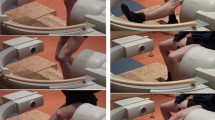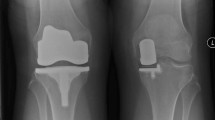Abstract
Purpose
The purpose of this study was to investigate the hypothesis that a medial unicompartmental knee arthroplasty might restore the functional flexion axis of a knee to normal. The flexion axis can be indirectly identified by tracking the vertical translation of anatomic landmarks that basically move around the flexion axis during a knee motion. If a unicompartmental knee could help restore the normal flexion axis, the anatomic landmarks after the arthroplasty would show the vertical translation similar to those of normal knees during a knee flexion.
Methods
While performing a squatting motion, the kinematics of 17 knees were determined before and after a medial unicompartmental arthroplasty to calculate the vertical translation of a clinical epicondylar axis, using a three- to two-dimensional registration technique through a single-plane fluoroscopic system incorporating a biplanar static radiography. The results were compared with a normal data, and a statistical analysis including a two-way repeated-measured analysis of variance was performed.
Results
For the medial end, from 10° to 100° knee flexion, normal, osteoarthritic, and unicompartmental knees had the average superior vertical translation of 7.3 ± 4.2, 4.3 ± 7.2, and 2.4 ± 3.1 mm, respectively, with statistical significance between normal and unicompartmental knees (p < 0.001). The vertical translation did not return to normal post-implantation.
Conclusions
A unicompartmental knee could not reproduce the normal flexion axis. As for clinical relevance, the changes of the implant design and surgical procedure may be necessary to obtain the normal flexion axis reproducing a normal motion.
Level of evidence
IV.








Similar content being viewed by others
References
Akizuki S, Mueller JK, Horiuchi H, Matsunaga D, Shibakawa A, Komistek RD (2009) In vivo determination of kinematics for subjects having a zimmer unicompartmental high flex knee system. J Arthroplast 24:963–971
Argenson JN, Chevrol-Benkeddache Y, Aubaniac JM (2002) Modern unicompartmental knee arthroplasty with cement. J Bone Joint Surg Am 84:2235–2239
Argenson JN, Komistek RD, Aubaniac JM, Dennis DA, Northcut EJ, Anderson DT, Agostini S (2002) In vivo determination of knee kinematics for subjects implanted with a unicompartmental arthroplasty. J Arthroplast 17:1049–1054
Asano T, Akagi M, Nakamura T (2005) The functional flexion-extension axis of the knee corresponds to the surgical epicondylar axis: in vivo analysis using a biplanar image matching technique. J Arthroplast 20:1060–1067
Becker R, Mauer C, Stärke C, Brosz M, Zantop T, Lohmann CH, Schulze M (2013) Anteroposterior and rotational stability in fixed and mobile bearing unicondylar knee arthroplasty: a cadaveric study using the robotic force sensor system. Knee Surg Sports Traumatol Arthrosc 21(11):2427–2432
Berger RA, Nedeff DD, Barden RM, Sheinkop MM, Jacobs JJ, Rosenberg AG, Galante JO (1999) Unicompartmental knee arthroplasty: clinical experience at 6- to 10-year follow-up. Clin Orthop Relat Res 367:50–60
Blaha JD (2002) A medial pivot geometry. Orthpedics 25:963–964
Blaha JD, Mancinelli CA, Simons WH, Kish VL, Thyagarajan G (2003) Kinematics of the human knee using an open chain cadaver model. Clin Orthop Relat Res 410:25–34
Blaha JD (2004) The rationale for a total knee implant that confers anteroposterior stability throughout range of motion. J Arthroplast 19:22–26
Brandt KD, Dieppe P, Radin EL (2008) Etiopathogenesis of osteoarthritis. Rheum Dis Clin North Am 34:531–559
Brouwer GM, van Tol AW, Bergink AP, Belo JN, Bernsen RM, Reijman M, Pols HA, Bierma-Zeinstra SM (2007) Association between valgus and varus alignment and the development and progression of radiographic osteoarthritis of the knee. Arthritis Rheum 56:1204–1211
Carr A, Keyes G, Miller R, O’Connor J, Goodfellow J (1993) Medial unicompartmental arthroplasty: a survival study of the Oxford meniscal knee. Clin Orthop Relat Res 295:205–213
Cerejo R, Dunlop DD, Cahue S, Channin D, Song J, Sharma L (2002) The influence of alignment on risk of knee osteoarthritis progression according to baseline stage of disease. Arthritis Rheum 46:2632–2636
Churchill DL, Incavo SJ, Johnson CC, Beynnon BD (1998) The transepicondylar axis approximates the optimal flexion axis of the knee. Clin Orthop Relat Res 356:111–118
Colle F, Bignozzi S, Lopomo N, Zaffagnini S, Sun L, Marcacci M (2012) Knee functional flexion axis in osteoarthritic patients: comparison in vivo with transepicondylar axis using a navigation system. Knee Surg Sports Traumatol Arthrosc 20:552–558
Eckhoff DG, Bach JM, Spitzer VM, Reining KD, Bagur MM, Baldini TH, Flannery NM (2005) Three-dimensional mechanics, kinematics, and morphology of the knee viewed in virtual reality. J Bone Joint Surg Am 87:71–80
Haaker P, Klotz E, Koppe R, Linde R (1990/91) Real-time distortion correction of digital X-ray 2/TV-systems: an application example for digital flashing tomosynthesis (DFTS). Int J Card Imaging 6:36–45
Hollister AM, Jatana A, Singh AK, Sullivan WW, Lupichuk AG (1993) The axes of rotation of the knee. Clin Orthop Relat Res 290:259–268
Kobayashi K, Tanaka N, Odagawa K, Sakamoto M, Tanabe Y (2009) Image-based matching for natural knee kinematics measurement using single-plane fluoroscopy. J Jpn Soc Exp Mech 9:162–166
Kobayashi K, Sakamoto K, Tanabe Y, Koga Y, Sakamoto K, Tanabe Y (2009) Automated image registration for three-dimensional alignment of entire lower extremity and implant position using bi-plane radiography. J Biomech 42:2818–2822
Mochizuki T, Sato T, Tanifuji O, Kobayashi K, Koga Y, Yamagiwa H, Omori G, Endo N (2013) In vivo pre- and postoperative three-dimensional knee kinematics in unicompartmental knee arthroplasty. J Orthop Sci 18:54–60
Mochizuki T, Sato T, Blaha JD, Tanifuji O, Kobayashi K, Yamagiwa H, Watanabe S, Matsueda M, Koga Y, Omori G, Endo N (2013) Kinematics of the knee after unicompartmental arthroplasty is not the same as normal and is similar to the kinematics of the knee with osteoarthritis. Knee Surg Sports Traumatol Arthrosc 22:1911–1917
Mochizuki T, Sato T, Blaha JD, Tanifuji O, Kobayashi K, Yamagiwa H, Watanabe S, Koga Y, Omori G, Endo N (2014) The clinical epicondylar axis is not the functional flexion axis of the human knee. J Orthop Sci 19:451–456
Most E, Axe J, Rubash H, Li G (2004) Sensitivity of the knee joint kinematics calculation to selection of flexion axes. J Biomech 37:1743–1748
Patil S, Colwell CW Jr, Ezzet KA, D’Lima DD (2005) Can normal knee kinematics be restored with unicompartmental knee replacement? J Bone Joint Surg Am 87(2):332–338
Sato T, Koga Y, Omori G (2004) Three-dimensional lower extremity alignment assessment system. J Arthroplast 19:620–628
Sharma L, Song J, Felson DT, Cahue S, Shamiyeh E, Dunlop DD (2001) The role of knee alignment in disease progression and functional decline in knee osteoarthritis. JAMA 286:188–195
Tanifuji O, Sato T, Kobayashi K, Mochizuki T, Koga Y, Yamagiwa H, Omori G, Endo N (2011) Three-dimensional in vivo motion analysis of normal knees using single-plane fluoroscopy. J Orthop Sci 16:710–718
Tanifuji O, Sato T, Kobayashi K, Mochizuki T, Koga Y, Yamagiwa H, Omori G, Endo N (2013) Three-dimensional in vivo motion analysis of normal knees employing transepicondylar axis as an evaluation parameter. Knee Surg Sports Traumatol Arthrosc 21:2301–2308
Yoshino N, Takai S, Ohtsuki Y, Hirasawa Y (2001) Computed tomography measurement of the surgical and clinical transepicondylar axis of the distal femur in osteoarthritic knees. J Arthroplast 16:493–497
Acknowledgments
This study would have been impossible without the cooperation of the Department of Radiology, Niigata Medical Center and Niigata University Hospital. The authors would like to thank all staff members of the department. The authors would also like to thank all staff members of LEXI Corporation, Tokyo, Japan, for their technical support.
Conflict of interest
The authors did not receive and will not receive any benefits or funding from any commercial party related directly or indirectly to the subject of this article.
Author information
Authors and Affiliations
Corresponding author
Rights and permissions
About this article
Cite this article
Mochizuki, T., Sato, T., Tanifuji, O. et al. Unicompartmental knee arthroplasty cannot restore the functional flexion axis of a living knee to normal. Knee Surg Sports Traumatol Arthrosc 23, 3736–3742 (2015). https://doi.org/10.1007/s00167-014-3296-7
Received:
Accepted:
Published:
Issue Date:
DOI: https://doi.org/10.1007/s00167-014-3296-7




